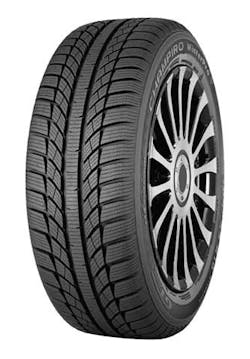GITI Tire made a big impression in the snow at a recent winter tire event in Quebec City, Quebec — a place where the average temperature in February is 9 degrees Fahrenheit.
Winter is the longest season in Quebec, where winter tire usage is mandatory from Nov. 15 through April 15. So it was a good place for GITI Tire (USA) Ltd. and GITI Tire (Canada) Ltd. to show off their new GT Radial Champiro WinterPro and IcePro tires.
The event was the official launch of the WinterPro., which had a soft launch last season in the Canadian market. While 2011 is the second year the IcePro has been available in the North American market, this was the first official event for the tire.
Both tires feature a tread compound made with the company’s NanoTek Silica technology and rubber polymers that maintain grip in icy temperatures.
Removing the elements
According to William Estupinan, GITI Tire’s director of technical service for North and Latin America, the tread compound formula for the new tires is designed for the best possible performance between 14 and 41 degrees F (that’s -10 to 5 degrees Celsius for metric Canadians). The WinterPro has a directional tread pattern with a center rib and sipes engineered to increase traction on slippery surfaces.
The WinterPro’s elliptic grooves in the tread design pump water away from the tire’s contact patch. Estupinan said that while the tread pattern and depth are important, the tread compound is actually the most important contributor to winter tire performance.
“The tread compound is one of the biggest differences between all-season tires and purpose-built winter tires,” he said. “Summer tires start to lose grip performance at 5 degrees C or 41 degrees F.”
The GT Radial Champiro IcePro has a new studdable distribution design that provides grip while reducing noise levels, the company says. Its lateral groove pattern is designed to remove slush and ice from the contact area.
The winter tire market is big business in North America. According to the Rubber Manufacturers Association, a total of 9.8 million original equipment and replacement traction and snow tread tires were shipped in 2010.
According to the Rubber Association of Canada, 7.2 million winter tires were shipped in Canada in 2010.
“Our message to drivers is: If you live in the snow belt, put on a set of purpose-built winter tires like the GT Radial Champiro WinterPro or IcePro for the winter,” said Tom McNamara, vice president of sales.
[PAGEBREAK]
McNamara emphasized “set” because he is adamant about replacing all four tires when buying winter tires.
“Putting winter tires on only the front or back axle is dangerous because one end of the vehicle will have a lot more traction than the other, causing understeer or oversteer.”
During the GITI-sponsored ride-and-drive event, drivers tested the new GT Radials against the Firestone Winterforce tire. In terms of quality, GITI says the tires compare favorably with tier two brands, although they are priced similarly to tier three competitors.
In addition to the Winterforce, the main competitors of the WinterPro and IcePro are winter tires from Kumho Tire U.S.A. Inc., Hankook Tire America Corp. and Toyo Tire U.S.A. Corp.
The Champiro WinterPro comes in 37 metric sizes ranging from 145/70R13 71T to 215/65R16 98H.
The Champiro IcePro comes in 41 T-rated metric passenger and SUV sizes ranging from 155/70R13 to 275/65R18. It also is available in five LT sizes.
GITI Tire (USA) and GITI Tire (Canada) are subsidiaries of GITI Tire Pte. Ltd. based in Singapore. The parent company has seven manufacturing facilities in China and one in Indonesia.
More than tires -- GITI also offers alloy wheels for winter
A new winter alloy wheel is available to dealers from GITI Tire (USA) Ltd. and GITI Tire (Canada) Ltd. The wheels initially are being sold as part of a wheel/tire package.
The wheels are manufactured by Seyen Alloy Wheel, a subsidiary of GITI Tire Pte. Ltd.
In addition to the new winter wheel, GITI is considering offering replacement alloy wheels in North America if business conditions are favorable.
Seyen Wheel produced 4 million alloy wheels in 2010. It projects production output of 5 million units in 2012 and 5.2 million units in 2013.
The company’s new plant in Suzhou-Wujiang, China, was scheduled to start production this month; the company anticipates manufacturing 1.2 million wheels in the plant by the end of the year.



